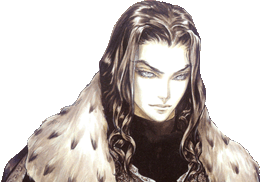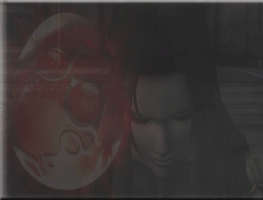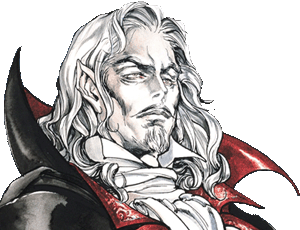Dracula
† Mathias is a variation of Matthias, the Apostle who replaced Judas Iscariot. The name means “God’s gift”.
† ‘Dracul’ originally meant “dragon” and later “the devil” in Romanian. The ‘A’ at the end means “son of”. Therefore Dracula means “son of the devil”.
† Cronqvist is a Swedish surname. This doesn’t necessarily mean Dracula is Swedish, especially since the names in the series have always been diversified and no way bound to the nomenclature of Romania or even the immediate areas around it. The whole name and Mathias’s clothing make it obvious that the inspiration for the character was the Hungarian king Matthias Corvinus. However, he ruled from 1458 to 1490, so the intention was probably never to draw a direct historical connection between Matthias I and Dracula. Curiously, Death refers to him as “king” in Lament of Innocence.
† Enters the scene precisely the same way in both Lament of Innocence and Curse of Darkness; breaking out with his eyes closed and sighing. This implies even more strongly that Dracula used to be Mathias, though this has already been confirmed by the developers before. Compared to the American and European versions of LoI this fact was a lot more directly presented in the Japanese version and left little to no room for speculation.
† According to the character profile found in the manual of SotN, Dracula’s whole name is “Dracula Vlad Tepes”. The game’s prologue presents him as “Vlad Tepes Dracula”. The same manual states Dracula “has been known by many names during the centuries”.
† Usual characteristics:
– Often sits on his throne waiting at the highest tower of his castle. Before the fight begins, he usually sips blood from a glass before shattering it on the floor.
– Teleports around, disappearing and appearing unexpectedly.
– Usual basic attack is three fireballs launched simultaneously.
– Rarely fights in one form. Mostly he transforms at least once into a large, monstrous creature, which is more powerful than the humanoid vampire form.
Appears:
All the games, except :
Lament of Innocence
Aria of Sorrow
Dawn of Sorrow
Playable:
Judgment
From life to anti-life 1094-1476
 No one else in Castlevania has gone through more profound character development than Dracula. He was originally a typical 1980’s video game villain with simple intentions and stereotypical appearance. Symphony of the Night revealed him as a man of revenge whose destructive acts were the result of a lost love.
No one else in Castlevania has gone through more profound character development than Dracula. He was originally a typical 1980’s video game villain with simple intentions and stereotypical appearance. Symphony of the Night revealed him as a man of revenge whose destructive acts were the result of a lost love.
Eventually with all his powers he also began resembling an evil spirit, who is not bound to a single person or body, affecting people’s free will and feeding on their greed and cruelty. He himself has stated on many occasions that it is the humans’ own insatiable lust for power that has enabled his return time after time.
Although he has been known as the legendary lord of vampires Dracula since the beginning of the series, Lament of Innocence exposed his original human identity as a calculative, brilliant tactician named Mathias Cronqvist. Finally, Dawn of Sorrow revealed he is also one of the rulers who balance the good and evil in the world.
Mathias Cronqvist was 32 during the events of LoI (1094). He was the tactical expert in a company of knights believed to be invincible. His education made him an exception in a largely illiterate society. Not much is known about his background, other than his family having a collection of alchemic knowledge passed on orally. With his friend Leon Belmont leading the group alongside him, the men travelled the world fighting heresy and heathens. Though Mathias himself had survived years on the battlefield, he couldn’t protect his wife Elizabetha, who awaited him at home, from whims of fate. Elizabetha fell ill and died. Mathias felt his world had collapsed. Grief-ridden, he lay in bed for a year and couldn’t continue fighting anymore, leaving Leon to lead the company alone.
While grieving for his loss, Mathias eventually lost faith in everything he had spent his life fighting for. He began blaming God for Elizabetha’s death and spent his time thinking of a way for a revenge against God, finally coming up with one. Turning into a vampire would be the perfect opposite for Mathias’s previous life, but allowing himself to be bitten was not suitable for his pride. He needed to use another way.
A long time ago, alchemists succeeded in creating three stones; the Philosopher’s Stone, the Ebony Stone and the Crimson Stone. The Philosopher’s stone granted its wielder eternal life. The Ebony Stone created an eternal night to a specific location and the Crimson stone gave an advantage over the powers of vampires. The location of the Philosopher’s Stone was unknown, but Mathias needed only the Crimson Stone to carry out his plan. It is unclear if a previous member of Mathias’ family, adept in the ways of alchemy, created or found the stone or if it was he himself who had achieved either. Either way, during the events of LoI, it is in his possession.
Walter Bernhard, who lived nearby, was one of the most powerful known vampires, who even had control over his undead brethren. Mathias knew Walter had the Ebony Stone, but getting it from him was not apparently his goal. Just like the Crimson Stone, it is assumed that the Ebony Stone chose its master too.
To defeat him, Mathias contacted Walter. He knew Walter searched the Crimson Stone compulsively and ”spiced up” his eternal life by robbing the spouses of strong warriors. This provoked them to enter his castle with vengeance in mind. No one had been able to defeat Walter so far but Mathias knew someone who could.
It is possible Mathias promised Walter information about the whereabouts of the Crimson Stone, provided he would do as Mathias wished; kidnap Leon’s betrothed, Sara Trantoul. Walter agreed and likely planned to use Death, whom he believed to be his ally, to eliminate Mathias after he was no longer of any use to him. But unknown to Walter, Death’s true and only master was in fact Mathias.
Mathias’ plan worked perfectly. Leon’s hate and the skills of Rinaldo Gandolfi created the Vampire Killer wich enabled Walter’s final defeat. Mathias stepped out of the shadows. As Death took Walter’s soul, Mathias used it and the Crimson Stone to be reborn as a vampire, effectively stealing Walter’s powers. Mathias explained everything to the baffled Leon and made one final attempt to lure his old friend and comrade to his cause of revenge.
Leon refused, so Mathias commanded Death to eliminate Leon while himself escaping to foreign lands to continue cursing God. It was not part of Mathias’s plan, however, that Death would fail in killing Leon, which happened. Like Mathias, Leon began a life’s work too; to stop Mathias and to battle other supernatural threats. But unlike Mathias, he would not fight alone; his descendants would continue his work.
With the Crimson Stone, Mathias’ powers continued to grow from the souls of destroyed vampires, which the Belmonts undoubtedly slew numerous over the nearly 400 years that followed Mathias’ escape. After this, the Belmonts and Mathias would finally face each other again.
The Dark Lord – 1476-1999
Despite his dark transformation, Mathias lived relatively peacefully for a long time. His hate was still directed only at God, whom he had vowed to curse and oppose for eternity. Eventually, Mathias met a woman who resembled his deceased wife remarkably much. The two fell in love and surprisingly, Mathias chose not to turn Lisa into what he had become, allowing her to maintain her humanity and suggesting that he himself had not wanted his own fate. They eventually married and Lisa gave birth to Mathias’s son, Adrian.
 Witch hunts were raging across Europe and Lisa, known as a great healer, was targeted by the paranoid townspeople. With Mathias unaware of the situation, the local village burned her as a witch. After hearing about it, likely from his son, all sympathy disappeared from him just as his humanity did when he gave up limited life.
Witch hunts were raging across Europe and Lisa, known as a great healer, was targeted by the paranoid townspeople. With Mathias unaware of the situation, the local village burned her as a witch. After hearing about it, likely from his son, all sympathy disappeared from him just as his humanity did when he gave up limited life.
Mathias turned his back on all feelings except contempt. Humans became his enemies and the time of peace ended. Mathias renamed himself Dracula. For the next couple of years, he focused on nothing else than growing his already considerable powers, after which he planned to destroy humankind completely.
It was around these times he began gaining servants and supporters. Among the most powerful of them were Isaac LaForeze and Hector, to whom Dracula personally taught the art of Devil Forging – the mystical ability to create demonic minions. Both disappeared from Dracula’s vicinity before the battle began; Hector left voluntarily after witnessing the brutal, systematic slaughtering of humans initiated by Dracula. Isaac went after him, likely to make Hector return to Dracula’s ranks.
After the true war began, two things contributed exceptionally much to Dracula’s first demise; Adrian (now calling himself ‘Alucard’, the reversal of ‘Dracula’) left his place at his father’s side, allying himself with Trevor Belmont and two other warriors who opposed Dracula. Dracula, however, feared nothing, especially defeat, since the Crimson Stone had fused into his soul, making sure that not even death would completely stop him. Trevor eventually struck the killing blow with the Vampire Killer within the chaotic castle borne of dark energy.
Dracula lost the battle, but would continue the war. He would resurrect many times during the hundreds of years to come, until the same weapon and the same blood defeated him apparently permanently; Julius Belmont, aided by several other warriors and experts of battling the supernatural, used the Vampire Killer to seal off the nullified power of Dracula and his castle into an eclipse, thus stopping the resurrection cycle with had enabled Dracula to return so many times to threaten the world.
The Vampire Killer was left inside the castle, keeping it imprisoned. Dracula was gone, but the soul which had originally belonged to Mathias, lived on. It wandered and finally found itself a new master, whom the castle and Dracula’s own power beckoned, 36 years after Dracula’s presumed final defeat.
Legacy and rebirth – 1999-2???
Dracula, or rather perhaps Mathias, was reborn as Soma Cruz – a foreign exchange student living in Japan. Not knowing his origin, Soma ends up in Dracula’s sealed castle, as if commanded by fate. In the castle he meets the weapons expert and merchant Hammer, the mysterious Genya Arikado, Yoko Belnades, who works for the church, the taciturn ‘J’ and Mina, Soma’s childhood friend and possible love interest. After facing Graham Jones, who believes himself to be a reincarnation of Dracula, Soma is forced to understand his origin. With the help of his friends and allies he fought his way to center of the dark side of his soul and succeeded in keeping the castle and his old, destructive side away.
But there will always be people willing to sacrifice almost anything to gain even a fraction of the power Dracula wielded. Therefore the cult led by Celia Fortner tracks Soma down a year later and lures him into their hideout. Celia’s intention is to bring back the Dark Lord, to create the perfect evil opposite for perfect good. That is why she believes Dracula needs to be brought back among the living.
After Soma thwarts the cult’s back up plan to create the Dark Lord from two other candidates, Celia stages something that almost succeeds in turning Soma into Dracula. Celia ”murders” a doppelganger of Mina in front of Soma’s eyes. Soma’s rage blazed and he was ready to kill Celia, but Arikado came in at the last minute to stop him.
Soma managed to keep his mind under control and eventually stopped the cult, destroying its headquarters. It seemed Soma finally had achieved the peace nether Mathias nor Dracula never had. Genya Arikado’s mysterious monologue at the end of DoS seemed ominous, but it is not sure if it had anything to do with Soma.
Powers and abilities
Dracula is clealy the most powerful character in the series. His powers include at least a certain degree of mind control, morphing, the ability to project energy and formidable skills in alchemy and dark magic. He also commands a vast army consisting of the undead, demons and inter-dimensional monsters. It is unclear if Death is more powerful than him, but since he apparently can’t act against Dracula, it can be assumed Dracula is even more powerful than him.
Dracula’s biggest weaknesses are arrogance and the Vampire Killer. Also, like other vampires, he is apparently vulnerable to sunlight. Whether or not it is completely lethal to him, is debatable.
Appearance, popularity and player perspective

Dracula’s appearance has been different in almost every game. In Aria of Sorrow it is subtly hinted that this is because the body Dracula takes over is different every time. Despite this, he has had many consistent characteristics, such as aristocratic clothing, goatee and long hair, a combination which can be called the “Bram Stoker template” (most distinctively seen in SotN and CoD,). The so-called “Bela Lugosi template” (Dracula’s Curse and Portrait of Ruin, for example) presents him clean-shaven with smooth facial features and short oily hair which is brushed backwards. His demonic appearance varies in his primary form or is nonexistent. The Dracula X Chronicles version combines these two basic types and interestingly, bears a slight resemblance to Koji Igarashi.
Dracula’s role in the series is directly tied to the number of the games he has been in. His canonical appearances include all games except Aria and Dawn of Sorrow. Even in them, he makes non-canonical appearances; in one of Aria of Sorrow’s endings, Dracula’s spirit takes hold of Soma, thus transforming him into Dracula. In Dawn of Sorrow, the same happens under different circumstances, enabling a new game mode. Neither is part of the official timeline, however. It can be argued whether or not he appears in Lament of Innocence as he didn’t go by the name of Dracula back then, but was still in the game under a different name.
From several different perspectives, Dracula is a tragic character, who, like many other flawed heroes, fell to the dark side. Mathias Cronqvist was originally an educated soldier, who, after losing his wife by accident, turned into a distorted reflection of his former self. However, in his absoluteness, he is an excellent antagonist to the Belmonts and other characters fighting him.
Though the heroes of the story are the Belmonts and the others who are against Dracula, his allies, his followers and their intentions, Castlevania is Dracula’s story too, as Lament of Innocence, the root of it all, demonstrates. His presence and the consequences of his actions have played a role in every game in the series, so it is with good reasons he can be called one of the series’ main characters.
Though Dracula is well recognized and popular as an adversary, many felt it especially auspicious to be able to ”play as Dracula” in Aria & Dawn of Sorrow. Many would like to replay the possibility, not only as Soma, but as Dracula – as he was known before Soma.
There is room for criticism too; Dracula’s most common attack patterns are sometimes too predictable. However this isn’t too common in the long run. Almost every time he has brought something new to his arsenal and attacks. Still, his constant role as a failing enemy should and could be getting more diverse aspects. There have been signs of this in a couple of games already.
